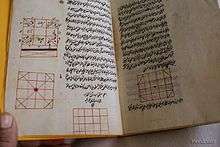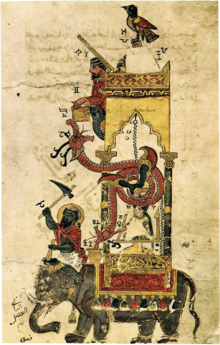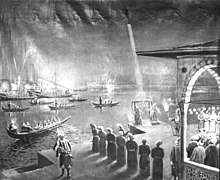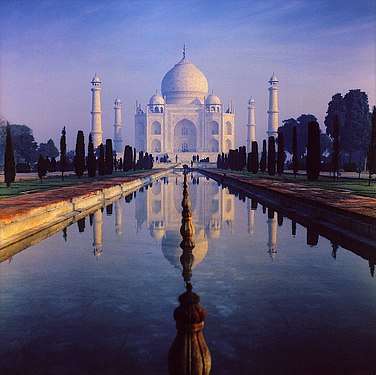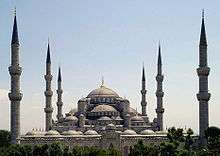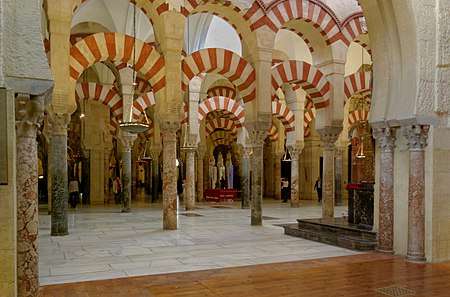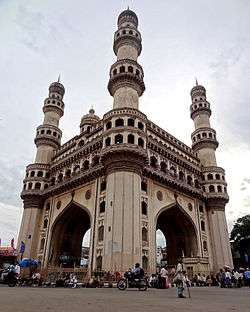Muslim world
The terms Muslim world and Islamic world commonly refer to the Islamic community (Ummah), consisting of all those who adhere to the religion of Islam,[2] or to societies where Islam is practiced.[3][4] In a modern geopolitical sense, these terms refer to countries where Islam is widespread, although there are no agreed criteria for inclusion.[5][4] The term Muslim-majority countries is an alternative often used for the latter sense.[6]
 World Muslim population by percentage (Pew Research Center, 2014) | |
| Population | 1.9 billion (as of 2017)[1] |
|---|---|
| Part of a series on |
| Islam |
|---|
 |
|
The history of the Muslim world spans about 1,400 years and includes a variety of socio-political developments, as well as advances in the arts, science, philosophy, and technology, particularly during the Islamic Golden Age. All Muslims look for guidance to the Quran and believe in the prophetic mission of Muhammad, but disagreements on other matters have led to the appearance of different religious schools of thought and sects within Islam.[7] In the modern era, most of the Muslim world came under European colonial domination. The nation states that emerged in the post-colonial era have adopted a variety of political and economic models, and they have been affected by secular and as well as religious trends.[8]
As of 2013, the combined GDP (nominal) of 49 Muslim majority countries was US$5.7 trillion,[9] As of 2016, they contributed 8% of the world's total.[10] As of 2015, 1.8 billion or about 24.1% of the world population are Muslims.[1] By the percentage of the total population in a region considering themselves Muslim, 91% in the Middle East-North Africa (MENA),[11] 89% in Central Asia,[12] 40% in Southeast Asia,[13] 31% in South Asia,[14][15] 30% in Sub-Saharan Africa,[16] 25% in Asia–Oceania,[17] around 6% in Europe,[18] and 1% in the Americas.[19][20][21][22]
Most Muslims are of one of two denominations: Sunni (75–90%)[23] and Shia (10–20%),[24] though in a large survey, about 25% identified as neither, but "just a Muslim".[25] About 13% of Muslims live in Indonesia, the largest Muslim-majority country;[26] 31% of Muslims live in South Asia,[27] the largest population of Muslims in the world;[28] 20% in the Middle East–North Africa,[29] where it is the dominant religion;[30] and 15% in Sub-Saharan Africa and West Africa.[31] Muslims are the overwhelming majority in Central Asia,[32] the majority in the Caucasus[33][34] and widespread in Southeast Asia.[35] India is the country with the largest Muslim population outside Muslim-majority countries.[36] Sizeable Muslim communities are also found in the Americas, China, Europe, and North Asia.[37][38][39] Islam is the fastest-growing major religion in the world.[40][41][42]
Terminology
In a modern geopolitical sense, the terms 'Muslim world' and 'Islamic world' refer to countries where Islam is widespread, although there are no agreed criteria for inclusion.[43][4] Some scholars and commentators have criticised the term 'Muslim/Islamic world' and its derivative terms 'Muslim/Islamic country' as "simplistic" and "binary", since no state has a religiously homogeneous population (e.g. Egypt's citizens are c. 10% Christians), and in absolute numbers, there are sometimes fewer Muslims living in countries where they make up the majority than in countries where they form a minority.[44][45][46] Hence, the term 'Muslim-majority countries' is often preferred in literature.[6]
History

The history of the Islamic faith as a religion and social institution begins with its inception around 610 CE, when the Islamic prophet Muhammad, a native of Mecca, is believed by Muslims to have received the first revelation of the Quran, and began to preach his message.[47] In 622 CE, facing opposition in Mecca, he and his followers migrated to Yathrib (now Medina), where he was invited to establish a new constitution for the city under his leadership.[47] This migration, called the Hijra, marks the first year of the Islamic calendar. By the time of his death, Muhammad had become the political and spiritual leader of Medina, Mecca, the surrounding region, and numerous other tribes in the Arabian Peninsula.[47]
After Muhammad died in 632, his successors (the Caliphs) continued to lead the Muslim community based on his teachings and guidelines of the Quran. The majority of Muslims consider the first four successors to be 'rightly guided' or Rashidun. The conquests of the Rashidun Caliphate helped to spread Islam beyond the Arabian Peninsula, stretching from northwest India, across Central Asia, the Near East, North Africa, southern Italy, and the Iberian Peninsula, to the Pyrenees. The Arab Muslims were unable to conquer the entire Christian Byzantine Empire in Asia Minor during the Arab–Byzantine wars, however. The succeeding Umayyad Caliphate attempted two failed sieges of Constantinople in 674–678 and 717–718. Meanwhile, the Muslim community tore itself apart into the rivalling Sunni and Shia sects since the killing of caliph Uthman in 656, resulting in a succession crisis that has never been resolved.[48] The following First, Second and Third Fitnas and finally the Abbasid Revolution (746–750) also definitively destroyed the political unity of the Muslims, who have been inhabiting multiple states ever since.[49] Ghaznavids' rule was succeeded by the Ghurid Empire of Muhammad of Ghor and Ghiyath al-Din Muhammad, whose reigns under the leadership of Muhammad bin Bakhtiyar Khalji extended until the Bengal, where Indian Islamic missionaries achieved their greatest success in terms of dawah and number of converts to Islam.[50][51] Qutb-ud-din Aybak conquered Delhi in 1206 and began the reign of the Delhi Sultanate,[52] a successive series of dynasties that synthesized Indian civilization with the wider commercial and cultural networks of Africa and Eurasia, greatly increased demographic and economic growth in India and deterred Mongol incursion into the prosperous Indo-Gangetic plain and enthroned one of the few female Muslim rulers, Razia Sultana.[53] Notable major empires dominated by Muslims, such as those of the Abbasids, Fatimids, Almoravids, Seljukids, Ajuran, Adal and Warsangali in Somalia, Mughals in the Indian subcontinent (India, Bangladesh, Afghanistan e.t.c), Safavids in Persia and Ottomans in Anatolia, were among the influential and distinguished powers in the world. 19th-century colonialism and 20th-century decolonisation have resulted in several independent Muslim-majority states around the world, with vastly differing attitudes towards and political influences granted to, or restricted for, Islam from country to country. These have revolved around the question of Islam's compatibility with other ideological concepts such as secularism, nationalism (especially Arab nationalism and Pan-Arabism, as opposed to Pan-Islamism), socialism (see also Arab socialism and socialism in Iran), democracy (see Islamic democracy), republicanism (see also Islamic republic), liberalism and progressivism, feminism, capitalism and more.
Classical culture
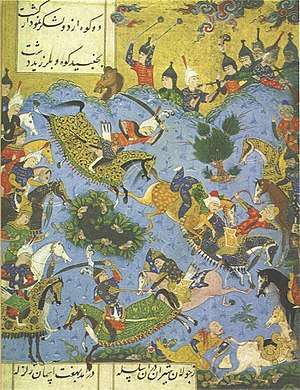
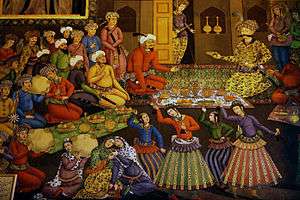 Shah of Safavid Empire Abbas I meet with Vali Muhammad Khan
Shah of Safavid Empire Abbas I meet with Vali Muhammad Khan Mir Sayyid Ali, a scholar writing a commentary on the Quran, during the reign of the Mughal Emperor Shah Jahan
Mir Sayyid Ali, a scholar writing a commentary on the Quran, during the reign of the Mughal Emperor Shah Jahan.jpg)
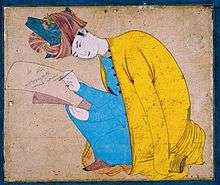 A Persian miniature of Shah Abu'l Ma‘ali, a scholar
A Persian miniature of Shah Abu'l Ma‘ali, a scholar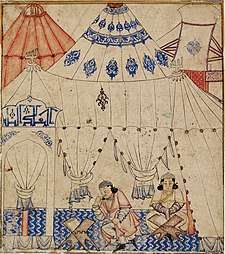
 Layla and Majnun studying together, from a Persian miniature painting
Layla and Majnun studying together, from a Persian miniature painting
The term "Islamic Golden Age" has been attributed to a period in history wherein science, economic development and cultural works in most of the Muslim-dominated world flourished.[54][55] The age is traditionally understood to have begun during the reign of the Abbasid caliph Harun al-Rashid (786–809) with the inauguration of the House of Wisdom in Baghdad, where scholars from various parts of the world sought to translate and gather all the known world's knowledge into Arabic,[56][57] and to have ended with the collapse of the Abbasid caliphate due to Mongol invasions and the Siege of Baghdad in 1258.[58] The Abbasids were influenced by the Quranic injunctions and hadiths, such as "the ink of a scholar is more holy than the blood of a martyr," that stressed the value of knowledge. The major Islamic capital cities of Baghdad, Cairo, and Córdoba became the main intellectual centers for science, philosophy, medicine, and education.[59] During this period, the Muslim world was a collection of cultures; they drew together and advanced the knowledge gained from the ancient Greek, Roman, Persian, Chinese, Indian, Egyptian, and Phoenician civilizations.[60]
Ceramics
Between the 8th and 18th centuries, the use of ceramic glaze was prevalent in Islamic art, usually assuming the form of elaborate pottery.[61] Tin-opacified glazing was one of the earliest new technologies developed by the Islamic potters. The first Islamic opaque glazes can be found as blue-painted ware in Basra, dating to around the 8th century. Another contribution was the development of fritware, originating from 9th-century Iraq.[62] Other centers for innovative ceramic pottery in the Old world included Fustat (from 975 to 1075), Damascus (from 1100 to around 1600) and Tabriz (from 1470 to 1550).[63]
Literature
_of_Fuzuli_-_Muhammad_bin_Sulayman_known_as_Fuzuli2.jpg) Hadiqatus-suada by Oghuz Turkic poet Fuzûlî
Hadiqatus-suada by Oghuz Turkic poet Fuzûlî The story of Princess Parizade and the Magic Tree.[64]
The story of Princess Parizade and the Magic Tree.[64] Ali Baba by Maxfield Parrish.
Ali Baba by Maxfield Parrish. The Magic carpet.
The Magic carpet.
The best known work of fiction from the Islamic world is One Thousand and One Nights (In Persian: hezār-o-yek šab > Arabic: ʔalf-layl-at-wa-l’-layla= One thousand Night and (one) Night) or *Arabian Nights, a name invented by early Western translators, which is a compilation of folk tales from Sanskrit, Persian, and later Arabian fables. The original concept is derived from a pre-Islamic Persian prototype Hezār Afsān (Thousand Fables) that relied on particular Indian elements.[65] It reached its final form by the 14th century; the number and type of tales have varied from one manuscript to another.[66] All Arabian fantasy tales tend to be called Arabian Nights stories when translated into English, regardless of whether they appear in The Book of One Thousand and One Nights or not.[66] This work has been very influential in the West since it was translated in the 18th century, first by Antoine Galland.[67] Imitations were written, especially in France.[68] Various characters from this epic have themselves become cultural icons in Western culture, such as Aladdin, Sinbad the Sailor and Ali Baba.
A famous example of Arabic poetry and Persian poetry on romance (love) is Layla and Majnun, dating back to the Umayyad era in the 7th century. It is a tragic story of undying love. Ferdowsi's Shahnameh, the national epic of Iran, is a mythical and heroic retelling of Persian history. Amir Arsalan was also a popular mythical Persian story, which has influenced some modern works of fantasy fiction, such as The Heroic Legend of Arslan.
Ibn Tufail (Abubacer) and Ibn al-Nafis were pioneers of the philosophical novel. Ibn Tufail wrote the first Arabic novel Hayy ibn Yaqdhan (Philosophus Autodidactus) as a response to Al-Ghazali's The Incoherence of the Philosophers, and then Ibn al-Nafis also wrote a novel Theologus Autodidactus as a response to Ibn Tufail's Philosophus Autodidactus. Both of these narratives had protagonists (Hayy in Philosophus Autodidactus and Kamil in Theologus Autodidactus) who were autodidactic feral children living in seclusion on a desert island, both being the earliest examples of a desert island story. However, while Hayy lives alone with animals on the desert island for the rest of the story in Philosophus Autodidactus, the story of Kamil extends beyond the desert island setting in Theologus Autodidactus, developing into the earliest known coming of age plot and eventually becoming the first example of a science fiction novel.[69][70]
Theologus Autodidactus,[71][72] written by the Arabian polymath Ibn al-Nafis (1213–1288), is the first example of a science fiction novel.[73] It deals with various science fiction elements such as spontaneous generation, futurology, the end of the world and doomsday, resurrection, and the afterlife. Rather than giving supernatural or mythological explanations for these events, Ibn al-Nafis attempted to explain these plot elements using the scientific knowledge of biology, astronomy, cosmology and geology known in his time. Ibn al-Nafis' fiction explained Islamic religious teachings via science and Islamic philosophy.[74]
A Latin translation of Ibn Tufail's work, Philosophus Autodidactus, first appeared in 1671, prepared by Edward Pococke the Younger, followed by an English translation by Simon Ockley in 1708, as well as German and Dutch translations. These translations might have later inspired Daniel Defoe to write Robinson Crusoe, regarded as the first novel in English.[75][76][77][78] Philosophus Autodidactus, continuing the thoughts of philosophers such as Aristotle from earlier ages, inspired Robert Boyle to write his own philosophical novel set on an island, The Aspiring Naturalist.[79]
Dante Alighieri's Divine Comedy,[80] derived features of and episodes about Bolgia[81] from Arabic works on Islamic eschatology:[82][83] the Hadith and the Kitab al-Miraj (translated into Latin in 1264 or shortly before[84] as Liber Scale Machometi[85]) concerning the ascension to Heaven of Muhammad,[86] and the spiritual writings of Ibn Arabi.[87] The Moors also had a noticeable influence on the works of George Peele and William Shakespeare. Some of their works featured Moorish characters, such as Peele's The Battle of Alcazar and Shakespeare's The Merchant of Venice, Titus Andronicus and Othello, which featured a Moorish Othello as its title character. These works are said to have been inspired by several Moorish delegations from Morocco to Elizabethan England at the beginning of the 17th century.[88]
Philosophy
One of the common definitions for "Islamic philosophy" is "the style of philosophy produced within the framework of Islamic culture."[89] Islamic philosophy, in this definition is neither necessarily concerned with religious issues, nor is exclusively produced by Muslims.[89] The Persian scholar Ibn Sina (Avicenna) (980–1037) had more than 450 books attributed to him. His writings were concerned with various subjects, most notably philosophy and medicine. His medical textbook The Canon of Medicine was used as the standard text in European universities for centuries. He also wrote The Book of Healing, an influential scientific and philosophical encyclopedia.
One of the most influential Muslim philosophers in the West was Averroes (Ibn Rushd), founder of the Averroism school of philosophy, whose works and commentaries affected the rise of secular thought in Europe.[90] He also developed the concept of "existence precedes essence".[91]
Another figure from the Islamic Golden Age, Avicenna, also founded his own Avicennism school of philosophy, which was influential in both Islamic and Christian lands. He was also a critic of Aristotelian logic and founder of Avicennian logic, developed the concepts of empiricism and tabula rasa, and distinguished between essence and existence.
Yet another influential philosopher who had an influence on modern philosophy was Ibn Tufail. His philosophical novel, Hayy ibn Yaqdha, translated into Latin as Philosophus Autodidactus in 1671, developed the themes of empiricism, tabula rasa, nature versus nurture,[92] condition of possibility, materialism,[93] and Molyneux's problem.[94] European scholars and writers influenced by this novel include John Locke,[95] Gottfried Leibniz,[78] Melchisédech Thévenot, John Wallis, Christiaan Huygens,[96] George Keith, Robert Barclay, the Quakers,[97] and Samuel Hartlib.[79]
Islamic philosophers continued making advances in philosophy through to the 17th century, when Mulla Sadra founded his school of Transcendent theosophy and developed the concept of existentialism.[98]
Other influential Muslim philosophers include al-Jahiz, a pioneer in evolutionary thought; Ibn al-Haytham (Alhazen), a pioneer of phenomenology and the philosophy of science and a critic of Aristotelian natural philosophy and Aristotle's concept of place (topos); Al-Biruni, a critic of Aristotelian natural philosophy; Ibn Tufail and Ibn al-Nafis, pioneers of the philosophical novel; Shahab al-Din Suhrawardi, founder of Illuminationist philosophy; Fakhr al-Din al-Razi, a critic of Aristotelian logic and a pioneer of inductive logic; and Ibn Khaldun, a pioneer in the philosophy of history.[99]
Sciences
|
Sciences |
|
|
|
|
Muslim scientists placed far greater emphasis on experiment than the Greeks. This led to an early scientific method being developed in the Muslim world, where progress in methodology was made, beginning with the experiments of Ibn al-Haytham (Alhazen) on optics from circa 1000, in his Book of Optics. The most important development of the scientific method was the use of experiments to distinguish between competing scientific theories set within a generally empirical orientation, which began among Muslim scientists. Ibn al-Haytham is also regarded as the father of optics, especially for his empirical proof of the intromission theory of light. Jim Al-Khalili stated in 2009 that Ibn al-Haytham is 'often referred to as the "world's first true scientist".'[100] al-Khwarzimi's invented the log base systems that are being used today, he also contributed theorems in trigonometry as well as limits.[101] Recent studies show that it is very likely that the Medieval Muslim artists were aware of advanced decagonal quasicrystal geometry (discovered half a millennium later in the 1970s and 1980s in the West) and used it in intricate decorative tilework in the architecture.[102]
Muslim physicians contributed to the field of medicine, including the subjects of anatomy and physiology: such as in the 15th-century Persian work by Mansur ibn Muhammad ibn al-Faqih Ilyas entitled Tashrih al-badan (Anatomy of the body) which contained comprehensive diagrams of the body's structural, nervous and circulatory systems; or in the work of the Egyptian physician Ibn al-Nafis, who proposed the theory of pulmonary circulation. Avicenna's The Canon of Medicine remained an authoritative medical textbook in Europe until the 18th century. Abu al-Qasim al-Zahrawi (also known as Abulcasis) contributed to the discipline of medical surgery with his Kitab al-Tasrif ("Book of Concessions"), a medical encyclopedia which was later translated to Latin and used in European and Muslim medical schools for centuries. Other medical advancements came in the fields of pharmacology and pharmacy.[103]
In astronomy, Muḥammad ibn Jābir al-Ḥarrānī al-Battānī improved the precision of the measurement of the precession of the Earth's axis. The corrections made to the geocentric model by al-Battani, Averroes, Nasir al-Din al-Tusi, Mu'ayyad al-Din al-'Urdi and Ibn al-Shatir were later incorporated into the Copernican heliocentric model. Heliocentric theories were also discussed by several other Muslim astronomers such as Al-Biruni, Al-Sijzi, Qotb al-Din Shirazi, and Najm al-Dīn al-Qazwīnī al-Kātibī. The astrolabe, though originally developed by the Greeks, was perfected by Islamic astronomers and engineers, and was subsequently brought to Europe.
Some most famous scientists from the medieval Islamic world include Jābir ibn Hayyān, al-Farabi, Abu al-Qasim al-Zahrawi, Ibn al-Haytham, Al-Biruni, Avicenna, Nasir al-Din al-Tusi, and Ibn Khaldun.
Technology
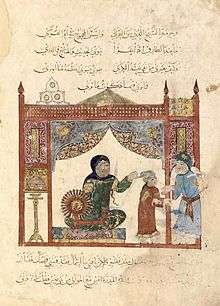
In technology, the Muslim world adopted papermaking from China.[104] The knowledge of gunpowder was also transmitted from China via predominantly Islamic countries,[105] where formulas for pure potassium nitrate[106][107] were developed.
Advances were made in irrigation and farming, using new technology such as the windmill. Crops such as almonds and citrus fruit were brought to Europe through al-Andalus, and sugar cultivation was gradually adopted by the Europeans. Arab merchants dominated trade in the Indian Ocean until the arrival of the Portuguese in the 16th century. Hormuz was an important center for this trade. There was also a dense network of trade routes in the Mediterranean, along which Muslim-majority countries traded with each other and with European powers such as Venice, Genoa and Catalonia. The Silk Road crossing Central Asia passed through Islamic states between China and Europe. The emergence of major economic empires with technological resources after the conquests of Timur (Tamerlane) and the resurgence of the Timurid Renaissance include the Mali Empire and the India's Bengal Sultanate in particular, a major global trading nation in the world, described by the Europeans to be the "richest country to trade with".[108]
Muslim engineers in the Islamic world made a number of innovative industrial uses of hydropower, and early industrial uses of tidal power and wind power,[109] fossil fuels such as petroleum, and early large factory complexes (tiraz in Arabic).[110] The industrial uses of watermills in the Islamic world date back to the 7th century, while horizontal-wheeled and vertical-wheeled water mills were both in widespread use since at least the 9th century. A variety of industrial mills were being employed in the Islamic world, including early fulling mills, gristmills, paper mills, hullers, sawmills, ship mills, stamp mills, steel mills, sugar mills, tide mills and windmills. By the 11th century, every province throughout the Islamic world had these industrial mills in operation, from al-Andalus and North Africa to the Middle East and Central Asia.[104] Muslim engineers also invented crankshafts and water turbines, employed gears in mills and water-raising machines, and pioneered the use of dams as a source of water power, used to provide additional power to watermills and water-raising machines.[111] Such advances made it possible for industrial tasks that were previously driven by manual labour in ancient times to be mechanized and driven by machinery instead in the medieval Islamic world. The transfer of these technologies to medieval Europe had an influence on the Industrial Revolution, particularly from the proto-industrialised Mughal Bengal and Tipu Sultan's Kingdom, through the conquests of the British East India Company.[112]
Gunpowder empires
Scholars often use the term Age of the Islamic Gunpowders to describe period the Safavid, Ottoman and Mughal states. Each of these three empires had considerable military exploits using the newly developed firearms, especially cannon and small arms, to create their empires.[113] They existed primarily between the fourteenth and the late seventeenth centuries.[114]During the 17th–18th centuries, when the Indian subcontinent was ruled by Mughal Empire's sixth ruler Muhammad Auranzgeb through sharia and Islamic economics,[115][116] India became the world's largest economy, valued 25% of world GDP,[117] having better conditions to 18th-century Western Europe, prior to the Industrial Revolution,[118] causing the emergence of the period of proto-industrialization.[118]
 Safavid Empire's Zamburak.
Safavid Empire's Zamburak.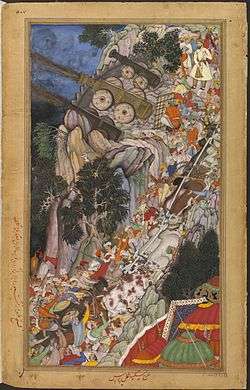 Bullocks dragging siege-guns up hill during Mughal Emperor Akbar's Siege of Ranthambore Fort in 1568.[119]
Bullocks dragging siege-guns up hill during Mughal Emperor Akbar's Siege of Ranthambore Fort in 1568.[119].jpg)
 Gun-wielding Ottoman Janissaries in combat against the Knights of Saint John at the Siege of Rhodes in 1522.
Gun-wielding Ottoman Janissaries in combat against the Knights of Saint John at the Siege of Rhodes in 1522.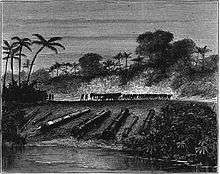 Cannons and guns belonging to the Aceh Sultanate (in modern Indonesia).
Cannons and guns belonging to the Aceh Sultanate (in modern Indonesia).
Great Divergence
Ibrahim Muteferrika, Rational basis for the Politics of Nations (1731)[120]
The Great Divergence and British colonialism were the reason why European colonial powers militarily defeated preexisting Oriental powers like the Mughal Empire, starting from the wealthy Bengal Subah, Tipu Sultan's Kingdom of Mysore, the Ottoman Empire and many smaller states in the pre-modern Greater Middle East, and initiated a period known as 'colonialism'.[120]
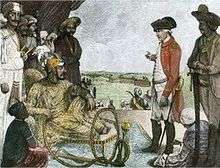 Mughal Emperor Shah Alam II negotiates with the British East India Company after being defeated during the Battle of Buxar.
Mughal Emperor Shah Alam II negotiates with the British East India Company after being defeated during the Battle of Buxar.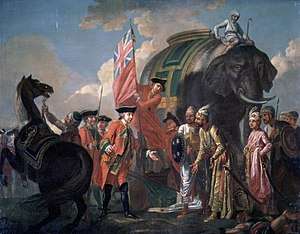

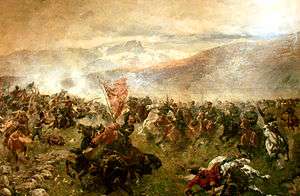 Combat during the Russo-Persian Wars).
Combat during the Russo-Persian Wars).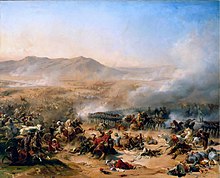 French campaign in Egypt and Syria against the Mamluks and Ottomans
French campaign in Egypt and Syria against the Mamluks and Ottomans
Colonialism
Beginning with the 15th century, colonialism by European powers (particularly, but not exclusively, Britain, Spain, Portugal, France, the Netherlands, Italy, Germany, Russia, Austria, and Belgium) profoundly affected Muslim-majority societies in Africa, Europe, the Middle East and Asia. Colonialism was often advanced by conflict with mercantile initiatives by colonial powers and caused tremendous social upheavals in Muslim-dominated societies.
A number of Muslim-majority societies reacted to Western powers with zealotry and thus initiating the rise of Pan-Islamism; or affirmed more traditionalist and inclusive cultural ideals; and in rare cases adopted modernity that was ushered by the colonial powers.[121]
The only Muslim-majority regions not to be colonized by the Europeans were Saudi Arabia, Iran, Turkey, and Afghanistan. Turkey was one of the first colonial powers of the world with the Ottoman empire ruling several states for over 6 centuries.
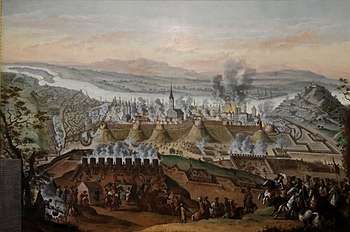
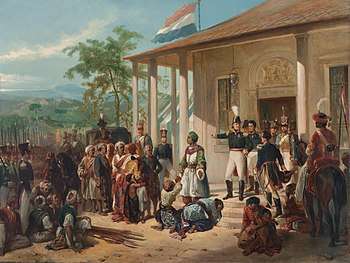
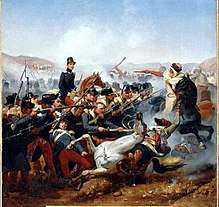 French conquest of Algeria (1830–1857)
French conquest of Algeria (1830–1857) Anglo-Egyptian invasion of Sudan 1896–1899
Anglo-Egyptian invasion of Sudan 1896–1899 The Melilla War between Spain and Rif Berbers of Morocco in 1909
The Melilla War between Spain and Rif Berbers of Morocco in 1909
Postcolonial era
The end of the European colonial domination has led to creation of a number of nation states with significant Muslim populations. These states drew on Islamic traditions to varying degree and in various ways in organizing their legal, educational and economic systems.[122]
Geography
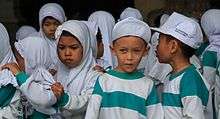
According to a 2010 study and released January 2011,[123][124] Islam had 1.5 billion adherents, making up c. 22% of the world population.[125][126][127] Because the terms 'Muslim world' and 'Islamic world' are disputed, since no country is homogeneously Muslim, and there is no way to determine at what point a Muslim minority in a country is to be considered 'significant' enough, there is no consensus on how to define the Muslim world geographically.[44][45][6] The only rule of thumb for inclusion which has some support, is that countries need to have a Muslim population of more than 50%.[44][6] According to the Pew Research Center in 2015 there were 50 Muslim-majority countries.[128][129] Jones (2005) defines a "large minority" as being between 30% and 50%, which described nine countries in 2000, namely Bosnia and Herzegovina, Eritrea, Ethiopia, Guinea-Bissau, Ivory Coast, Kazakhstan, Nigeria, North Macedonia, and Tanzania.[6]
In its list of Islamic countries of the world, WorldAtlas identifies six major Islamic states, meaning countries that base their systems of government on Sharia law: Iran, Pakistan, Saudi Arabia, Afghanistan, Mauritania, and Yemen. Other countries not considered Islamic states, but which politically define Islam as the state religion, are listed as: Egypt, Jordan, Iraq, Kuwait, Algeria, Malaysia, Maldives, Morocco, Libya, Tunisia, United Arab Emirates, Somalia, and Brunei. It is noted that Libya also has 18 other official state religions. Neutral Muslim majority countries, in which Islam is not the state religion, are: Niger, Indonesia, Sudan, Bosnia and Herzegovina, Sierra Leone, and Djibouti. Countries with a majority of Muslims, that have declared an official separation of religion and state, are listed as secular Muslim majority countries: Albania, Azerbaijan, Bangladesh, Burkina Faso, Chad, The Gambia, Guinea, Kazakhstan, Kosovo, Kyrgyzstan, Mali, Northern Cyprus, Nigeria, Senegal, Syria, Lebanon, Tajikistan, Turkmenistan, Turkey, and Uzbekistan.[130]
Government
Religion and state
As the Muslim world came into contact with secular ideals, societies responded in different ways. Some Muslim-majority countries are secular. Azerbaijan became the first secular republic in the Muslim world, between 1918 and 1920, before it was incorporated into the Soviet Union.[131][132][133] Turkey has been governed as a secular state since the reforms of Mustafa Kemal Atatürk.[134] By contrast, the 1979 Iranian Revolution replaced a monarchial semi-secular regime with an Islamic republic led by the Ayatollah, Ruhollah Khomeini.[135][136]
Some countries have declared Islam as the official state religion. In those countries, the legal code is largely secular. Only personal status matters pertaining to inheritance and marriage are governed by Sharia law.
Islamic states
Islamic states have adopted Islam as the ideological foundation of state and constitution.
State religion
The following Muslim-majority nation-states have endorsed Islam as their state religion, and though they may guarantee freedom of religion for citizens, do not declare a separation of state and religion:

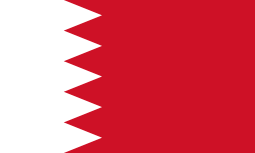
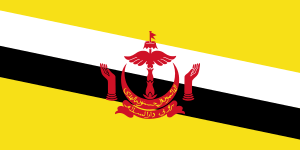
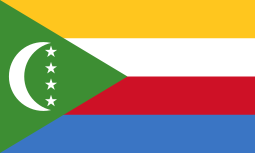
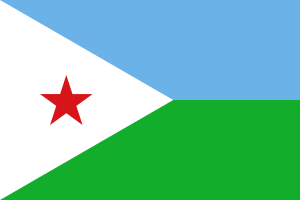

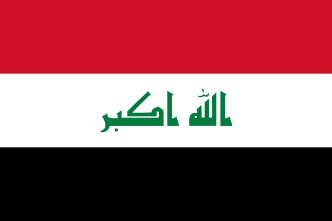

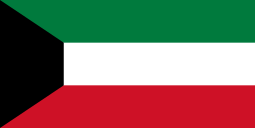
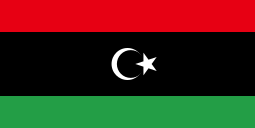

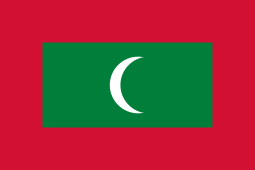

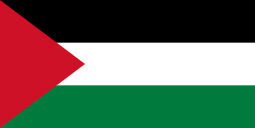

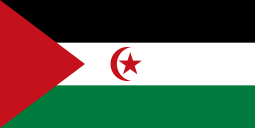
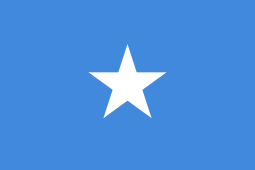

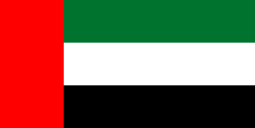
Unclear or no declaration
These are neutral states where the constitutional or official announcement regarding status of religion is not clear or unstated.
Secular states
Secular states in the Muslim world have declared separation between civil/government affairs and religion.
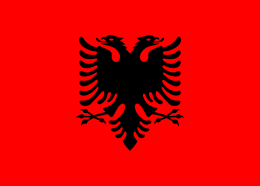



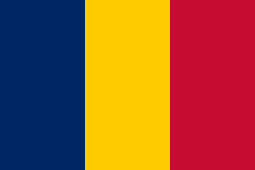
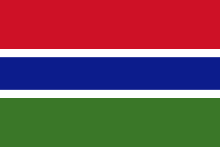

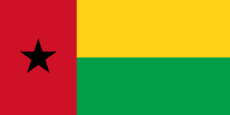
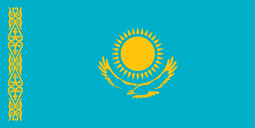

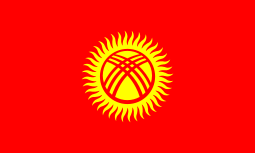
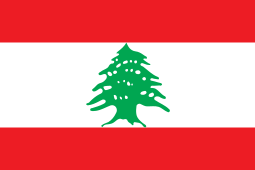

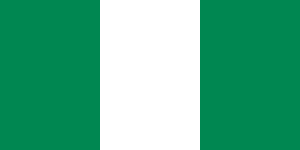
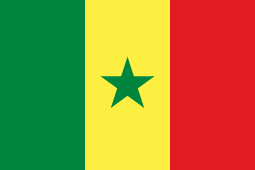
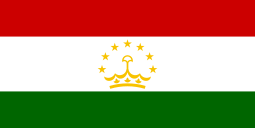

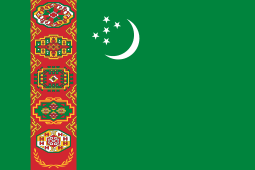
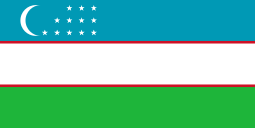
Law and ethics
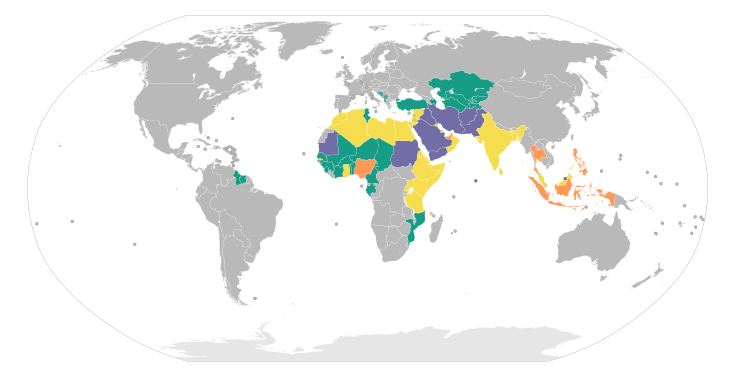
In some states, Muslim ethnic groups enjoy considerable autonomy.
In some places, Muslims implement Islamic law, called sharia in Arabic. The Islamic law exists in a number of variations, but the main forms are the five (four Sunni and one Shia) and Salafi and Ibadi schools of jurisprudence (fiqh)
- Hanafi school in Pakistan, North India, Afghanistan, Bangladesh, Turkey, Albania, Kosovo, Bosnia and Herzegovina, other Balkan States, Lower Egypt, Spain, Canada, Jordan, Lebanon, Iraq, Russia, Caucasus Republics, China, Central Asian Republics, European Union, other countries of North and South America.
- Maliki in North Africa, West Africa, Sahel, Qatar, United Arab Emirates and Kuwait.
- Shafi'i in Malaysia, Indonesia, Brunei, Eritrea, Somalia, Yemen, Maldives, Sri Lanka and South India
- Hanbali in Saudi Arabia,
- Jaferi in Iran, Iraq, Bahrain and Azerbaijan. These four are the only "Muslim states" where the majority is Shia population. In Yemen, Pakistan, India, Afghanistan, Tajikistan, Saudi Arabia, Kuwait, Turkey, and Syria, are countries with Sunni populations. In Lebanon, the majority Muslims (54%) were about equally divided between Sunni and Shia in 2010.
- Ibadi in Oman and small regions in North Africa
In a number of Muslim-majority countries the law requires women to cover either their legs, shoulders and head, or the whole body apart from the face. In strictest forms, the face as well must be covered leaving just a mesh to see through. These hijab rules for dressing cause tensions, concerning particularly Muslims living in Western countries, where restrictions are considered both sexist and oppressive. Some Muslims oppose this charge, and instead declare that the media in these countries presses on women to reveal too much in order to be deemed attractive, and that this is itself sexist and oppressive.
Politics
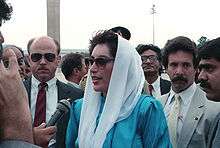
During much of the 20th century, the Islamic identity and the dominance of Islam on political issues have arguably increased during the early 21st century. The fast-growing interests of the Western world in Islamic regions, international conflicts and globalization have changed the influence of Islam on the world in contemporary history.[188]
Democracy and compulsion indexes
The Open Doors USA organization, in its 2012 survey of countries around the world that persecute Christians, listed 37 members of the Muslim world amongst the top 50 countries where Christians face the most severe persecution. 9 of the top 10 countries are Islamic-majority states.[189]
Islamism
Some people in Muslim-majority countries also see Islam manifested politically as Islamism.[190] Political Islam is powerful in some Muslim-majority countries. Islamic parties in Turkey, Pakistan and Algeria have taken power at the provincial level. Some in these movements call themselves Islamists, which also sometimes describes more militant Islamic groups. The relationships between these groups (in democratic countries there is usually at least one Islamic party) and their views of democracy are complex.
Some of these groups are accused of practicing Islamic terrorism.
Islam-based intergovernmental organizations
| Organisation of Islamic Cooperation |
|---|
| Economy |
| Education |
| Member states |
|
| Parliamentary Union |
The Organisation of Islamic Cooperation (OIC) is an inter-governmental organization grouping fifty-seven states. 49 are Muslim-majority countries, the others have significant Muslim minorities. The organization claims to be the collective voice of the Muslim world to safeguard the interest and ensure the progress and well-being of their peoples and those of other Muslims in the world over.
Economy
The Muslim world has been afflicted with economic stagnation for many centuries.[191][192] In 2011, U.S. President Barack Obama stated that apart from crude oil, the exports of the entire Greater Middle East with its 400 million population roughly equals that of Switzerland.[193] It has also been estimated that the exports of Finland, a European country of only five million, exceeded those of the entire 370 million-strong Arab world, excluding oil and natural gas.[194]
Education
In most Muslim-majority countries, illiteracy is a problem, whereas in others literacy rates are high. In Egypt, the largest Muslim-majority Arab country, the youth female literacy rate exceeds that for males.[195] Lower literacy rates are more prevalent in South Asian countries such as in Afghanistan and Pakistan, but are rapidly increasing.[196] In the Eastern Middle East, Iran has a high level of youth literacy at 98%,[197] whereas Iraq's youth literacy rate has sharply declined from 85% to 57%, during the American-led war and subsequent occupation.[198] Indonesia, the largest Muslim-majority country in the world, has a very high youth literacy rate at 99%.[199]
In Afghanistan, seminaries are operated by politically active religious organizations and have taken the place of basic education not provided and funded by the government.
A 2016 Pew Research Center study about religion and education around the world found that Muslims have the lowest average levels of education after Hindus, with an average of 5.6 years of schooling.[200] About 36% of all Muslims have no formal schooling,[200] Muslims have also the lowest average levels of higher education of any major religious group, with only 8% having graduate and post-graduate degrees.[200] The highest of years of schooling among Muslim-majority countries found in Uzbekistan (11.5),[200] Kuwait (11.0)[200] and Kazakhstan (10.7).[200] In addition, the average of years of schooling in countries where Muslims are the majority is 6.0 years of schooling, which lag behind the global average (7.7 years of schooling).[200] In the youngest age (25–34) group surveyed, Young Muslims have the lowest average levels of education of any major religious group, with an average of 6.7 years of schooling, which lag behind the global average (8.6 years of schooling).[200] The study found that Muslims have a significant amount of gender inequality in educational attainment, since Muslim women have an average of 4.9 years of schooling; compare to an average of 6.4 years of schooling among Muslim men.[200]
- Young school girls in Paktia Province of Afghanistan.
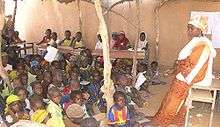 A primary classroom in Niger.
A primary classroom in Niger.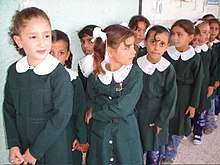 Schoolgirls in Gaza lining up for class, 2009.
Schoolgirls in Gaza lining up for class, 2009.
Literacy
The literacy rate in the Muslim world varies. Azerbaijan is in second place in the Index of Literacy of World Countries. Some members such as Iran, Kuwait, Kazakhstan, Tajikistan and Turkmenistan have over 97% literacy rates, whereas literacy rates are the lowest in Mali, Afghanistan, Chad and parts of Africa. In 2015, the International Islamic News Agency reported that nearly 37% of the population of the Muslim world is unable to read or write, basing that figure on reports from the Organisation of Islamic Cooperation and the Islamic Educational, Scientific and Cultural Organization.[201]
Demographics
More than 24.1% of the world's population is Muslim.[204][205] Current estimates conclude that the number of Muslims in the world is around 1.8 billion.[204] Muslims are the majority in 49 countries,[206] they speak hundreds of languages and come from diverse ethnic backgrounds. Major languages spoken by Muslims include Arabic, Bengali, Urdu, Hindi, Punjabi, Malay, Javanese, Sundanese, Tagalog, Swahili, Hausa, Fula, Berber, Tuareg, Somali, Albanian, Spanish, Bosnian, Russian, Turkish, Azeri, Kazakh, Kannada, Uzbek, Tatar, Persian, Kurdish, Pashto, Tamil, Telugu, Balochi, Sindhi, Malayalam, Gujarati, Marathi, Assamese, Yoruba language and Kashmiri, among many others.
Religion
The two main denominations of Islam are the Sunni and Shia sects. They differ primarily upon of how the life of the ummah ("faithful") should be governed, and the role of the imam. Sunnis believe that the true political successor of the Prophet according to the Sunnah should be selected based on ٍShura (consultation), as was done at the Saqifah which selected Abu Bakr, Muhammad's father-in-law, to be Muhammad's political but not his religious successor. Shia, on the other hand, believe that Muhammad designated his son-in-law Ali ibn Abi Talib as his true political as well as religious successor.[207]
The overwhelming majority of Muslims in the world, between 87–90%, are Sunni.[208]
Shias and other groups make up the rest, about 10–13% of overall Muslim population. The countries with the highest concentration of Shia populations are: Iran – 89%,[209] Azerbaijan – 85%,[210] Iraq – 60/70%,[211] Bahrain – 70%, Yemen – 47%,[212] Turkey – 28%,[213][214][215] Lebanon – 27%, Syria – 17%, Afghanistan – 15%, Pakistan – 5%/10%,[216][217][218][219][220][221][222][223][224] and India – 5%.[225]
The Kharijite Muslims, who are less known, have their own stronghold in the country of Oman holding about 75% of the population.[226]
 Turkish Muslims at the Eyüp Sultan Mosque on Eid al-Adha
Turkish Muslims at the Eyüp Sultan Mosque on Eid al-Adha
- Friday prayer for Sunni Muslims in Dhaka, Bangladesh
Islamic schools and branches
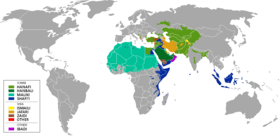
The first centuries of Islam gave rise to three major sects: Sunnis, Shi'as and Kharijites. Each sect developed distinct jurisprudence schools (madhhab) reflecting different methodologies of jurisprudence (fiqh).
The major Sunni madhhabs are Hanafi, Maliki, Shafi'i, and Hanbali.
The major Shi'a branches are Twelver (Imami), Ismaili (Sevener) and Zaidi (Fiver). Isma'ilism later split into Nizari Ismaili and Musta’li Ismaili, and then Mustaali was divided into Hafizi and Taiyabi Ismailis.[227] It also gave rise to the Qarmatian movement and the Druze faith. Twelver Shiism developed Ja'fari jurisprudence whose branches are Akhbarism and Usulism, and other movements such as Alawites, Shaykism[228] and Alevism.[229][230]
Similarly, Kharijites were initially divided into five major branches: Sufris, Azariqa, Najdat, Adjarites and Ibadis. Among these numerous branches, only Hanafi, Maliki, Shafi'i, Hanbali, Imamiyyah-Ja'fari-Usuli, Nizārī Ismā'īlī, Alevi,[231] Zaydi, Ibadi, Zahiri, Alawite,[232] Druze and Taiyabi communities have survived. In addition, new schools of thought and movements like Quranist Muslims, Ahmadi Muslims and African American Muslims later emerged independently.
.jpg)
_-_Nebi_Shueib_Festival.jpg)
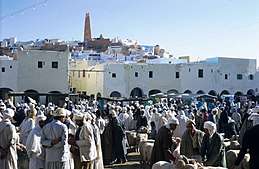

 Most of the inhabitants of the Hunza Valley in Pakistan are Ismaili Muslims
Most of the inhabitants of the Hunza Valley in Pakistan are Ismaili Muslims
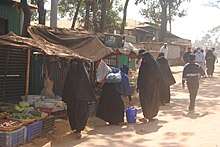
Refugees
According to the UNHCR, Muslim-majority countries hosted 18 million refugees by the end of 2010.
Since then Muslim-majority countries have absorbed refugees from recent conflicts, including the uprising in Syria.[233] In July 2013, the UN stated that the number of Syrian refugees had exceeded 1.8 million.[234] In Asia, an estimated 625,000 refugees from Rakhine, Myanmar, mostly Muslim, had crossed the border into Bangladesh since August 2017.[235]
Culture
Throughout history, Muslim cultures have been diverse ethnically, linguistically and regionally.
|
Islamic architecture |
|
|
|
Arts
The term "Islamic art and architecture" denotes the works of art and architecture produced from the 7th century onwards by people who lived within the territory that was inhabited by culturally Islamic populations.[236][237]
Architecture
Encompassing both secular and religious styles, the design and style made by Muslims and their construction of buildings and structures in Islamic culture included the architectural types: the Mosque, the Tomb, the Palace and the Fort. Perhaps the most important expression of Islamic art is architecture, particularly that of the mosque.[238] Through Islamic architecture, effects of varying cultures within Islamic civilization can be illustrated. Generally, the use of Islamic geometric patterns and foliage based arabesques were striking. There was also the use of decorative calligraphy instead of pictures which were haram (forbidden) in mosque architecture. Note that in secular architecture, human and animal representation was indeed present.
The North African and Iberian Islamic architecture, for example, has Roman-Byzantine elements, as seen in the Great Mosque of Kairouan which contains marble columns from Roman and Byzantine buildings,[239] in the Alhambra palace at Granada, or in the Great Mosque of Cordoba.
Persian-style mosques are characterized by their tapered brick pillars, large arcades, and arches supported each by several pillars. In South Asia, elements of Hindu architecture were employed, but were later superseded by Persian designs.
Aniconism
No Islamic visual images or depictions of God are meant to exist because it is believed that such artistic depictions may lead to idolatry. Moreover, Muslims believe that God is incorporeal, making any two- or three- dimensional depictions impossible. Instead, Muslims describe God by the names and attributes that, according to Islam, he revealed to his creation. All but one sura of the Quran begins with the phrase "In the name of God, the Beneficent, the Merciful". Images of Mohammed are likewise prohibited. Such aniconism and iconoclasm[240] can also be found in Jewish and some Christian theology.
Arabesque
Islamic art frequently adopts the use of geometrical floral or vegetal designs in a repetition known as arabesque. Such designs are highly nonrepresentational, as Islam forbids representational depictions as found in pre-Islamic pagan religions. Despite this, there is a presence of depictional art in some Muslim societies, notably the miniature style made famous in Persia and under the Ottoman Empire which featured paintings of people and animals, and also depictions of Quranic stories and Islamic traditional narratives. Another reason why Islamic art is usually abstract is to symbolize the transcendence, indivisible and infinite nature of God, an objective achieved by arabesque.[241] Islamic calligraphy is an omnipresent decoration in Islamic art, and is usually expressed in the form of Quranic verses. Two of the main scripts involved are the symbolic kufic and naskh scripts, which can be found adorning the walls and domes of mosques, the sides of minbars, and so on.[241]
Distinguishing motifs of Islamic architecture have always been ordered repetition, radiating structures, and rhythmic, metric patterns. In this respect, fractal geometry has been a key utility, especially for mosques and palaces. Other features employed as motifs include columns, piers and arches, organized and interwoven with alternating sequences of niches and colonnettes.[242] The role of domes in Islamic architecture has been considerable. Its usage spans centuries, first appearing in 691 with the construction of the Dome of the Rock mosque, and recurring even up until the 17th century with the Taj Mahal. And as late as the 19th century, Islamic domes had been incorporated into European architecture.[243]
 Example of an Arabesque
Example of an Arabesque Example of an Arabesque
Example of an Arabesque Example of an Arabesque
Example of an Arabesque
Girih
Girih is an Islamic decorative art form used in architecture and handicrafts (book covers, tapestry, small metal objects), consisting of geometric lines that form an interlaced strapwork.
Islamic calligraphy
Islamic calligraphy, is the artistic practice of handwriting, calligraphy, and by extension, of bookmaking, in the lands sharing a common Islamic cultural heritage.
 Kufic script from an early Qur'an manuscript, 7th century. (Surah 7: 86–87)
Kufic script from an early Qur'an manuscript, 7th century. (Surah 7: 86–87)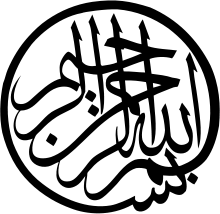 Bismallah calligraphy.
Bismallah calligraphy. Islamic calligraphy represented for amulet of sailors in the Ottoman Empire.
Islamic calligraphy represented for amulet of sailors in the Ottoman Empire. Islamic calligraphy praising Ali.
Islamic calligraphy praising Ali. Modern Islamic calligraphy representing various planets.
Modern Islamic calligraphy representing various planets.
Calendar
Islamic lunar calendar

The Islamic calendar, Muslim calendar or Hijri calendar (AH) is a lunar calendar consisting of 12 months in a year of 354 or 355 days. It is used to date events in many Muslim-majority countries and determines the proper days on which to observe the annual fast (see Ramadan), to attend Hajj, and to celebrate other Islamic holidays and festivals.
Solar Hijri calendar

The Solar Hijri calendar, also called the Shamsi Hijri calendar, and abbreviated as SH, is the official calendar of Iran and Afghanistan. It begins on the vernal equinox. Each of the twelve months corresponds with a zodiac sign. The first six months have 31 days, the next five have 30 days, and the last month has 29 days in usual years but 30 days in leap years. The year of Prophet Muhammad's migration to Medina (622 CE) is fixed as the first year of the calendar, and the New Year's Day always falls on the March equinox.
Contemporary developments
 Ceiling with Islamic patterns at the Museum of Islamic Art, Doha.
Ceiling with Islamic patterns at the Museum of Islamic Art, Doha.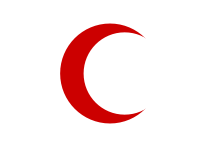 The Red Crescent is recognized in 33 countries.
The Red Crescent is recognized in 33 countries.
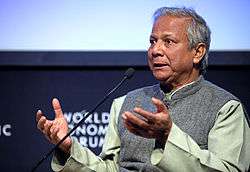
As of 2015 Islam has 1.8 billion adherents, making up over 24.1% of the world population.[1] Due to globalization, Islam today has taken root and influenced cultures in places far from the traditional boundaries of the Muslim world.[244]
Gallery
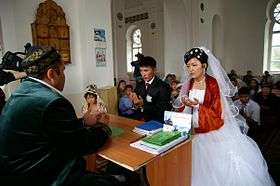 A Kazakh wedding ceremony in a mosque
A Kazakh wedding ceremony in a mosque
 Muslim girls at Istiqlal Mosque in Jakarta
Muslim girls at Istiqlal Mosque in Jakarta A tribal delegation in Chad
A tribal delegation in Chad Minangkabau people (Padang, Indonesia) Reciting Al-Qur'an
Minangkabau people (Padang, Indonesia) Reciting Al-Qur'an.jpg) Muslim Girls walking for school in Bangladesh
Muslim Girls walking for school in Bangladesh
See also
Notes
References
Citations
- Michael Lipka & Conrad Hackett (6 April 2017). "Why Muslims are the world's fastest-growing religious group". Pew Research Center. Archived from the original on 23 August 2017. Retrieved 14 February 2018.
- Marilyn R. Waldman; Malika Zeghal (2009). "Islamic world". Britannica. Archived from the original on 2 February 2017. Retrieved 29 January 2017.
- John L. Esposito, ed. (2009). "Preface". The Oxford Encyclopedia of the Islamic World. Oxford: Oxford University Press. doi:10.1093/acref/9780195305135.001.0001. ISBN 9780195305135.
The Oxford Encyclopedia of the Islamic World (OEIW) deals with all aspects of Islam—the world's second largest and fastest-growing religion—and the societies in which it exists, including their religion, politics, economics, everyday life, culture, and thought
- Asma Afsaruddin (2016). "Islamic World". In William H. McNeill (ed.). Berkshire Encyclopedia of World History. 1 (2nd ed.). Berkshire Publishing Group. doi:10.1093/acref/9780190622718.001.0001. ISBN 9781933782652.
The Islamic world is generally defined contemporaneously as consisting of nation-states whose population contains a majority of Muslims. [...] in the contemporary era, the term Islamic world now includes not only the traditional heartlands of Islam, but also Europe and North America, both of which have sizeable minority Muslim populations
- Scott Carpenter, Soner Cagaptay (2 June 2009). "What Muslim World?". Foreign Policy. Archived from the original on 26 March 2017. Retrieved 10 March 2017.
- Jones, Gavin W. (2005). Islam, the State and Population. C. Hurst & Co. Publishers. pp. 11–14. ISBN 9781850654933. Retrieved 19 September 2017.
- Editors, History com. "Islam". HISTORY. Retrieved 22 July 2020.CS1 maint: extra text: authors list (link)
- Ira M. Lapidus (2014). A History of Islamic Societies. Cambridge University Press (Kindle edition). pp. 829–834. ISBN 978-0-521-51430-9.
- "Economies of the ummah". Archived from the original on 16 December 2017. Retrieved 16 December 2017.
- "Muslim countries make thin contribution to global economy". 22 September 2016. Archived from the original on 13 August 2018. Retrieved 16 December 2017.
- "Region: Middle East-North Africa". The Future of the Global Muslim Population. Pew Research Center. 27 January 2011. Archived from the original on 9 March 2013. Retrieved 3 January 2012.
- "The Global Religious Landscape" (PDF). Pew. December 2012. Archived from the original (PDF) on 24 September 2015.
- "Oxford Islamic Studies Online". www.oxfordislamicstudies.com. Archived from the original on 20 March 2017. Retrieved 14 March 2017.
- "Region: Asia-Pacific". Pew Research Center's Religion & Public Life Project. 27 January 2011. Archived from the original on 10 October 2017. Retrieved 13 March 2017.
- Burke, Daniel. "The moment American Muslims were waiting for". CNN Religion. Archived from the original on 12 March 2017. Retrieved 13 March 2017.
- "Region: Sub-Saharan Africa". The Future of the Global Muslim Population. Pew Research Center. Archived from the original on 9 March 2013. Retrieved 3 January 2012.
- "Region: Asia-Pacific". The Future of the Global Muslim Population. Pew Research Center. Archived from the original on 9 March 2013. Retrieved 3 January 2012.
- "Region: Europe". The Future of the Global Muslim Population. Pew Research Center. Archived from the original on 7 April 2013. Retrieved 3 January 2012.
- "Region: Americas". The Future of the Global Muslim Population. Pew Research Center. Archived from the original on 7 April 2013. Retrieved 3 January 2012.
- Tom Kington (31 March 2008). "Number of Muslims ahead of Catholics, says Vatican". The Guardian. Archived from the original on 2 September 2013. Retrieved 17 November 2008.
- "Muslim Population". IslamicPopulation.com. Archived from the original on 25 May 2013. Retrieved 17 November 2008.
- "Field Listing Religions". Archived from the original on 4 June 2011. Retrieved 17 November 2008.
-
- "Mapping the Global Muslim Population: A Report on the Size and Distribution of the World's Muslim Population". Pew Research Center. 7 October 2009. Retrieved 24 September 2013.
Of the total Muslim population, 10–13% are Shia Muslims and 87–90% are Sunni Muslims.
- Sunni Islam: Oxford Bibliographies Online Research Guide "Sunni Islam is the dominant division of the global Muslim community, and throughout history it has made up a substantial majority (85 to 90 percent) of that community."
- "Sunni". Berkley Center for Religion, Peace, and World Affairs. Retrieved 20 December 2012.
Sunni Islam is the largest denomination of Islam, comprising about 85% of the world's over 1.5 billion Muslims.
- "Religions". The World Factbook. Central Intelligence Agency. Retrieved 25 August 2010.
Sunni Islam accounts for over 75% of the world's Muslim population...
- "Mapping the Global Muslim Population: A Report on the Size and Distribution of the World's Muslim Population". Pew Research Center. 7 October 2009. Retrieved 24 September 2013.
- See
- "Shiʿi". Encyclopædia Britannica Online. 4 October 2019. Retrieved 30 September 2019.
In the early 21st century some 10–13 percent of the world’s 1.6 billion Muslims were Shiʿi.
- "Mapping the Global Muslim Population: A Report on the Size and Distribution of the World's Muslim Population". Pew Research Center. 7 October 2009. Retrieved 24 September 2013.
The Pew Forum's estimate of the Shia population (10–13%) is in keeping with previous estimates, which generally have been in the range of 10–15%. Some previous estimates, however, have placed the number of Shias at nearly 20% of the world's Muslim population.
- "Shia". Berkley Center for Religion, Peace, and World Affairs. Archived from the original on 15 December 2012. Retrieved 5 December 2011.
Shi'a Islam is the second largest branch of the tradition, with up to 200 million followers who comprise around 15% of all Muslims worldwide...
- Jalil Roshandel (2011). Iran, Israel and the United States. Praeger Security International. p. 15.
The majority of the world's Islamic population, which is Sunni, accounts for over 75 percent of the Islamic population; the other 10 to 20 percent is Shia.
- "Shiʿi". Encyclopædia Britannica Online. 4 October 2019. Retrieved 30 September 2019.
- Lugo, Luis; Cooperman, Alan (9 August 2012). "The World's Muslims: Unity and Diversity - Preface". Pew Research Center. Retrieved 8 March 2020.
- "10 Countries With the Largest Muslim Populations, 2010 and 2050date=2015-04-02". Pew Research Center's Religion & Public Life Project. Retrieved 7 February 2017.
- Pechilis, Karen; Raj, Selva J. (2013). South Asian Religions: Tradition and Today. Routledge. p. 193. ISBN 9780415448512.
- Diplomat, Akhilesh Pillalamarri, The. "How South Asia Will Save Global Islam". The Diplomat. Retrieved 7 February 2017.
- "Middle East-North Africa Overview". Pew Research Center's Religion & Public Life Project. 7 October 2009. Retrieved 18 January 2018.
- "Region: Middle East-North Africa". The Future of the Global Muslim Population. Pew Research Center. 27 January 2011. Retrieved 22 December 2011.
- "Region: Sub-Saharan Africa". The Future of the Global Muslim Population. Pew Research Center. 27 January 2011. Retrieved 22 December 2011.
- Rowland, Richard H. "CENTRAL ASIA ii. Demography". Encyclopaedia Iranica. 2. pp. 161–164. Retrieved 25 May 2017.
- "Middle East :: Azerbaijan — The World Factbook - Central Intelligence Agency". www.cia.gov. Retrieved 1 December 2019.
- "The Many Languages of Islam in the Caucasus". Eurasianet. Retrieved 1 December 2019.
- Yusuf, Imtiyaz. "The Middle East and Muslim Southeast Asia: Implications of the Arab Spring". Oxford Islamic Studies. Archived from the original on 20 March 2017.
- "India invited as 'Guest of Honour' to OIC meet, Sushma Swaraj to attend". @businessline.
- "Book review: Russia's Muslim Heartlands reveals diverse population", The National, 21 April 2018, retrieved 13 January 2019
- "Muslim Population by Country". The Future of the Global Muslim Population. Pew Research Center. Archived from the original on 9 February 2011. Retrieved 22 December 2011.
- "Islam in Russia". www.aljazeera.com.
- "Main Factors Driving Population Growth". Pew Research Center's Religion & Public Life Project. 2 April 2015. Retrieved 23 October 2018.
- Burke, Daniel (4 April 2015). "The world's fastest-growing religion is ..." CNN. Retrieved 18 April 2015.
- Lippman, Thomas W. (7 April 2008). "No God But God". U.S. News & World Report. Retrieved 24 September 2013.
Islam is the youngest, the fastest growing, and in many ways the least complicated of the world's great monotheistic faiths. It is based on its own holy book, but it is also a direct descendant of Judaism and Christianity, incorporating some of the teachings of those religions—modifying some and rejecting others.
- Scott Carpenter, Soner Cagaptay (2 June 2009). "What Muslim World?". Foreign Policy.
- Nawaz, Maajid (2012). Radical: My Journey out of Islamist Extremism. WH Allen. p. XXII–XIII. ISBN 9781448131617. Retrieved 19 September 2017.
- Christopher Hitchens (2007). "Hitchens '07: Danish Muhammad Cartoons". Christopher Hitchens and Tim Rutten in discussion. Archived from the original on 22 April 2016. Retrieved 19 September 2017.
21 ambassadors from Muslim – so-called "Muslim states". How do they dare to call themselves "Muslim"? In what sense is Egypt a "Muslim" country? You can't denominate a country as religious.
(4:35) - Gert Jan Geling (12 January 2017). "Ook na 1400 jaar kan de islam heus verdwijnen". Trouw (in Dutch). Retrieved 3 October 2017.
"Many people, including myself, are often guilty of using terms such as 'Muslim countries', or the 'Islamic world', as if Islam has always been there, and always will be. And that is completely unclear. (...) If the current trend [of apostasy] continues, at some point a large section of the population may no longer be religious. How 'Islamic' would that still make the 'Islamic world'?
- Watt, William Montgomery (2003). Islam and the Integration of Society. Psychology Press. p. 5. ISBN 978-0-415-17587-6.
- Encarta-encyclopedie Winkler Prins (1993–2002) s.v. "islam. §7. Sektevorming". Microsoft Corporation/Het Spectrum.
- Encarta-encyclopedie Winkler Prins (1993–2002) s.v. "Omajjaden §1. De Spaanse tak". Microsoft Corporation/Het Spectrum.
- The preaching of Islam: a history of the propagation of the Muslim faith By Sir Thomas Walker Arnold, pp. 227-228
- Majumdar, Dr. R.C., History of Mediaeval Bengal, First published 1973, Reprint 2006,Tulshi Prakashani, Kolkata, ISBN 81-89118-06-4
- Srivastava, Ashirvadi Lal (1929). The Sultanate Of Delhi 711–1526 AD. Shiva Lal Agarwala & Company.
- "Delhi Sultanate", Wikipedia, 3 July 2019, retrieved 7 July 2019
- George Saliba (1994), A History of Arabic Astronomy: Planetary Theories During the Golden Age of Islam, pp. 245, 250, 256–7. New York University Press, ISBN 0-8147-8023-7.
- King, David A. (1983). "The Astronomy of the Mamluks". Isis. 74 (4): 531–555. doi:10.1086/353360.CS1 maint: ref=harv (link)
- Medieval India, NCERT, ISBN 81-7450-395-1
- Vartan Gregorian, "Islam: A Mosaic, Not a Monolith", Brookings Institution Press, 2003, pg 26–38 ISBN 0-8157-3283-X
- Islamic Radicalism and Multicultural Politics. Taylor & Francis. 1 March 2011. p. 9. ISBN 978-1-136-95960-8. Retrieved 26 August 2012.
- George Saliba (July 1995). A History of Arabic Astronomy: Planetary Theories During the Golden Age of Islam. ISBN 9780814780237. Retrieved 24 October 2012.
- Vartan Gregorian, "Islam: A Mosaic, Not a Monolith", Brookings Institution Press, 2003, pp. 26–38 ISBN 0-8157-3283-X
- Mason, Robert (1995)."New Looks at Old Pots: Results of Recent Multidisciplinary Studies of Glazed Ceramics from the Islamic World". Muqarnas V 12 p.1
- Mason, Robert (1995)."New Looks at Old Pots: Results of Recent Multidisciplinary Studies of Glazed Ceramics from the Islamic World". Muqarnas V 12 p. 5
- Mason, Robert (1995)."New Looks at Old Pots: Results of Recent Multidisciplinary Studies of Glazed Ceramics from the Islamic World". Muqarnas V 12 p. 7
- The Thousand and One Nights; Or, The Arabian Night's Entertainments - David Claypoole Johnston - Google Books. Books.google.com.pk. Retrieved on 23 September 2013.
- Marzolph (2007). "Arabian Nights". Encyclopaedia of Islam. I. Leiden: Brill.
- Grant & Clute, p. 51
- L. Sprague de Camp, Literary Swordsmen and Sorcerers: The Makers of Heroic Fantasy, p. 10 ISBN 0-87054-076-9
- Grant & Clute, p 52
- Dr. Abu Shadi Al-Roubi (1982), "Ibn Al-Nafis as a philosopher", Symposium on Ibn al-Nafis, Second International Conference on Islamic Medicine: Islamic Medical Organization, Kuwait (cf. Ibn al-Nafis As a Philosopher Archived 6 February 2008 at the Wayback Machine, Encyclopedia of Islamic World).
- Nahyan A. G. Fancy (2006), "Pulmonary Transit and Bodily Resurrection: The Interaction of Medicine, Philosophy and Religion in the Works of Ibn al-Nafīs (d. 1288) Archived 4 April 2015 at the Wayback Machine", pp. 95–101, Electronic Theses and Dissertations, University of Notre Dame.
- Muhammad b. Abd al-Malik Ibn Tufayl. Philosophus autodidactus, sive Epistola Abi Jaafar ebn Tophail de Hai ebn Yokdhan: in qua ostenditur, quomodo ex inferiorum contemplatione ad superiorum notitiam ratio humana ascendere possit. E Theatro Sheldoniano, excudebat Joannes Owens, 1700.
- Ala-al-din abu Al-Hassan Ali ibn Abi-Hazm al-Qarshi al-Dimashqi. The Theologus autodidactus of Ibn al-Nafīs. Clarendon P., 1968
- Gregory Claeys (2010), The Cambridge Companion to Utopian Literature, Cambridge University Press, p. 236
- Dr. Abu Shadi Al-Roubi (1982), "Ibn Al-Nafis as a philosopher", Symposium on Ibn al Nafis, Second International Conference on Islamic Medicine: Islamic Medical Organization, Kuwait (cf. Ibnul-Nafees As a Philosopher Archived 6 February 2008 at the Wayback Machine, Encyclopedia of Islamic World).
- Nawal Muhammad Hassan (1980), Hayy bin Yaqzan and Robinson Crusoe: A study of an early Arabic impact on English literature, Al-Rashid House for Publication.
- Cyril Glasse (2001), New Encyclopaedia of Islam, p. 202, Rowman Altamira, ISBN 0-7591-0190-6.
- Amber Haque (2004), "Psychology from Islamic Perspective: Contributions of Early Muslim Scholars and Challenges to Contemporary Muslim Psychologists", Journal of Religion and Health 43 (4): 357–77 [369].
- Martin Wainwright, Desert island scripts Archived 17 January 2008 at the Wayback Machine, The Guardian, 22 March 2003.
- G. J. Toomer (1996), Eastern Wisedome and Learning: The Study of Arabic in Seventeenth-Century England, p. 222, Oxford University Press, ISBN 0-19-820291-1.
- The Inferno. Dante Alighieri. Bickers and Son, 1874.
- See Inferno (Dante); Eighth Circle (Fraud)
- Miguel Asín Palacios, Julián Ribera, Real Academia Española. La Escatologia Musulmana en la Divina Comedia. E. Maestre, 1819.
- See also: Miguel Asín Palacios.
- I. Heullant-Donat and M.-A. Polo de Beaulieu, "Histoire d'une traduction," in Le Livre de l'échelle de Mahomet, Latin edition and French translation by Gisèle Besson and Michèle Brossard-Dandré, Collection Lettres Gothiques, Le Livre de Poche, 1991, p. 22 with note 37.
- Tr. The Book of Muhammad's Ladder
- Transliterated as Maometto.
- The Review: May-Dec. 1919, Volume 1. The National Weekly Corp., 1919. p. 128.
- Professor Nabil Matar (April 2004), Shakespeare and the Elizabethan Stage Moor, Sam Wanamaker Fellowship Lecture, Shakespeare’s Globe Theatre (cf. Mayor of London (2006), Muslims in London Archived 26 June 2008 at the Wayback Machine, pp. 14–15, Greater London Authority)
- "Islamic Philosophy" Archived 3 May 2015 at WebCite, Routledge Encyclopedia of Philosophy (1998)
- Majid Fakhry (2001). Averroes: His Life, Works and Influence. Oneworld Publications. ISBN 1-85168-269-4.
- Irwin, Jones (Autumn 2002). "Averroes' Reason: A Medieval Tale of Christianity and Islam". The Philosopher. LXXXX (2).
- Russell (1994), pp. 224–62,
- Dominique Urvoy, "The Rationality of Everyday Life: The Andalusian Tradition? (Aropos of Hayy's First Experiences)", in Lawrence I. Conrad (1996), The World of Ibn Tufayl: Interdisciplinary Perspectives on Ḥayy Ibn Yaqẓān, pp. 38–46, Brill Publishers, ISBN 90-04-09300-1.
- Muhammad ibn Abd al-Malik Ibn Tufail and Léon Gauthier (1981), Risalat Hayy ibn Yaqzan, p. 5, Editions de la Méditerranée.
- Russell (1994), pp. 224–39
- Russell (1994) p. 227
- Russell (1994), p. 247
- Kamal, Muhammad (2006). Mulla Sadra's Transcendent Philosophy. Ashgate Publishing, Ltd. pp. 9, 39. ISBN 978-0-7546-5271-7. OCLC 224496901.
- Dr. S.R.W. Akhtar (1997). "The Islamic Concept of Knowledge", Al-Tawhid: A Quarterly Journal of Islamic Thought & Culture 12 (3).
- Al-Khalili, Jim (4 January 2009). "BBC News". Archived from the original on 26 April 2015. Retrieved 11 April 2014.
- Plofker, Kim (2009), Mathematics in India: 500 BCE–1800 CE, Princeton, NJ: Princeton University Press. p. 384., ISBN 0-691-12067-6.
- Peter J. Lu, Harvard's Office of News and Public Affairs Archived 14 March 2007 at the Wayback Machine
- Turner, H. (1997) pp. 136–38
- Adam Robert Lucas (2005), "Industrial Milling in the Ancient and Medieval Worlds: A Survey of the Evidence for an Industrial Revolution in Medieval Europe", Technology and Culture 46 (1), pp. 1–30 [10].
- Arming the Periphery. Emrys Chew, 2012. p. 1823.
- Ahmad Y. al-Hassan, Potassium Nitrate in Arabic and Latin Sources Archived 26 February 2008 at the Wayback Machine, History of Science and Technology in Islam.
- Ahmad Y. al-Hassan, Gunpowder Composition for Rockets and Cannon in Arabic Military Treatises In Thirteenth and Fourteenth Centuries Archived 26 February 2008 at the Wayback Machine, History of Science and Technology in Islam.
- Nanda, J. N (2005). Bengal: the unique state. Concept Publishing Company. p. 10. 2005. ISBN 978-81-8069-149-2. Bengal [...] was rich in the production and export of grain, salt, fruit, liquors and wines, precious metals and ornaments besides the output of its handlooms in silk and cotton. Europe referred to Bengal as the richest country to trade with.
- Ahmad Y. al-Hassan (1976). Taqi al-Din and Arabic Mechanical Engineering, pp. 34–35. Institute for the History of Arabic Science, University of Aleppo.
- Maya Shatzmiller, p. 36.
- Ahmad Y. al-Hassan, Transfer Of Islamic Technology To The West, Part II: Transmission Of Islamic Engineering Archived 18 February 2008 at the Wayback Machine
- Adam Robert Lucas (2005), "Industrial Milling in the Ancient and Medieval Worlds: A Survey of the Evidence for an Industrial Revolution in Medieval Europe", Technology and Culture 46 (1), pp. 1–30.
- Evans, Charles T. "The Gunpowder Empires". Northern Virginia Community College. Archived from the original on 26 May 2011. Retrieved 28 December 2010.
- "The Islamic Gunpowder Empires, 1300–1650". Civilization Past & Present. Pearson Education. Archived from the original on 24 July 2011. Retrieved 28 December 2010.
- Islamic and European Expansion: The Forging of a Global Order, Michael Adas, Temple University Press (Philadelphia, PA), 1993.
- Chapra, Muhammad Umer (2014). Morality and Justice in Islamic Economics and Finance. Edward Elgar Publishing. pp. 62–63. ISBN 9781783475728.
- Maddison, Angus (2003): Development Centre Studies The World Economy Historical Statistics: Historical Statistics, OECD Publishing, ISBN 9264104143, pages 259–261
- Lex Heerma van Voss; Els Hiemstra-Kuperus; Elise van Nederveen Meerkerk (2010). "The Long Globalization and Textile Producers in India". The Ashgate Companion to the History of Textile Workers, 1650–2000. Ashgate Publishing. p. 255.
- Unknown (1590–95). "Bullocks dragging siege-guns up hill during Akbar's attack on Ranthambhor Fort". the Akbarnama. Archived from the original on 19 May 2014. Retrieved 19 May 2014.
- "The 6 killer apps of prosperity". Archived from the original on 13 February 2014. Retrieved 5 August 2014.
- Levy, Jacob T., ed. (2011). Colonialism and Its Legacies. (Contributors: Alfred T, Chakabarty D, Dussel E, Eze E, Hsueh V, Kohn M, Bhanu Mehta P, Muthu S, Parekh B, Pitts J, Schutte O, Souza J, Young IM). Lanham: Rowman & Littlefield Publishers Group. ISBN 9780739142943.
- "Islamic world". Britannica.
- "Muslim Population by Country". The Future of the Global Muslim Population. Pew Research Center. Archived from the original on 9 February 2011. Retrieved 22 December 2011.
- "Preface", The Future of the Global Muslim Population, Pew Research Center, 27 January 2011, archived from the original on 25 July 2013, retrieved 6 August 2014
- "Executive Summary". The Future of the Global Muslim Population. Pew Research Center. 27 January 2011. Archived from the original on 5 August 2013. Retrieved 22 December 2011.
- "Christian Population as Percentages of Total Population by Country". Global Christianity. Pew Research Center. Archived from the original on 7 January 2012. Retrieved 22 December 2011.
- "Turmoil in the world of Islam". Deccan Chronicle. 14 June 2014. Archived from the original on 15 July 2014. Retrieved 6 August 2014.
- "What is each country's second-largest religious group?". Archived from the original on 22 June 2015. Retrieved 22 June 2015.
- "Muslim-Majority Countries". The Future of the Global Muslim Population. Pew Research Center. 27 January 2011. Archived from the original on 20 November 2011. Retrieved 22 December 2011.
- "Islamic Countries Of The World". WorldAtlas. Retrieved 29 July 2020.
- "93 years pass since establishment of first democratic republic in the east – Azerbaijan Democratic Republic". Azerbaijan Press Agency. Archived from the original on 21 November 2011. Retrieved 28 May 2011.
- Kazemzadeh, Firuz (1951). The Struggle for Transcaucasia: 1917–1921. The New York Philosophical Library. pp. 124, 222, 229, 269–70. ISBN 978-0-8305-0076-5.
- Swietochowski, Tadeusz (2004). Russian Azerbaijan, 1905–1920: The Shaping of a National Identity in a Muslim Community. Cambridge University Press. p. 129. ISBN 978-0-521-52245-8. Archived from the original on 17 January 2018. Retrieved 17 January 2018.
- Helen Rose Fuchs Ebaugh (2009), The Gülen Movement: A Sociological Analysis of a Civic Movement Rooted in Moderate Islam. Springer, p. 116
- See:
- Esposito (2004), p. 84
- Lapidus (2002), pp. 502–07, 845
- Lewis (2003), p. 100
- 1906 Constitution of Imperial Iran: Article 1 - "The official religion of Persia is Islám, according to the orthodox Já'farí doctrine of the Ithna 'Ashariyya (Church of the Twelve Imáms), which faith 1 the Sháh of Persia must profess and promote."
- "Constitution of Afghanistan 2004". Archived from the original on 23 February 2017. Retrieved 23 February 2017.
- "Islamic Republic of Iran Constitution". Archived from the original on 25 February 2008. Retrieved 23 February 2017.
- "Mauritania's Constitution of 1991 with Amendments through 2012" (PDF). Archived (PDF) from the original on 4 May 2017. Retrieved 23 February 2017.
- "Oman's Constitution of 1996 with Amendments through 2011" (PDF). Archived (PDF) from the original on 27 January 2017. Retrieved 23 February 2017.
- "The Constitution of the Islamic Republic of Pakistan". Archived from the original on 9 July 2011. Retrieved 27 November 2010.
- "Basic Law of Saudi Arabia". Archived from the original on 26 December 2011. Retrieved 6 January 2012.
- "Yemen's Constitution of 1991 with Amendments through 2001" (PDF). Archived (PDF) from the original on 27 January 2017. Retrieved 23 February 2017.
- "Of the People's Democratic Republic of Algeria" (PDF). Archived (PDF) from the original on 4 May 2017. Retrieved 23 February 2017.
- "Constitution of the Kingdom of Bahrain (2002)". Archived from the original on 23 February 2017. Retrieved 23 February 2017.
- "The World Factbook". Cia.gov. Archived from the original on 21 July 2015. Retrieved 30 December 2013.
- "Comoros's Constitution of 2001 with Amendments through 2009" (PDF). Archived (PDF) from the original on 4 May 2017. Retrieved 23 February 2017.
- "Djibouti's Constitution of 1992 with Amendments through 2010" (PDF). Archived (PDF) from the original on 25 June 2016. Retrieved 23 February 2017.
- "Egypt's Constitution of 2014" (PDF). Archived (PDF) from the original on 4 May 2017. Retrieved 23 February 2017.
- "Constitution of Iraq" (PDF). Archived from the original (PDF) on 28 November 2016.
- "Jordan country report" Archived 29 June 2011 at the Wayback Machine, The World Factbook, U.S. Central Intelligence Agency, 24 August 2012
- "International Religious Freedom Report". US State Department. 2002. Retrieved 24 June 2017.
- "Libya's Constitution of 2011 with Amendments through 2012" (PDF). Archived (PDF) from the original on 27 January 2017. Retrieved 23 February 2017.
- "Constitution of Malaysia" (PDF). Archived (PDF) from the original on 14 May 2011. Retrieved 23 February 2017.
- "Constitution of the Republic of Maldives 2008" (PDF). Archived from the original (PDF) on 19 May 2017. Retrieved 23 February 2017.
- "Morocco's Constitution of 2011" (PDF). Archived (PDF) from the original on 27 January 2017. Retrieved 23 February 2017.
- "Qatar's Constitution of 2003" (PDF). Archived (PDF) from the original on 27 January 2017. Retrieved 23 February 2017.
- Janos, Besenyo (2009). Western Sahara (PDF). Pécs: Publikon Publishers. ISBN 978-963-88332-0-4. Archived (PDF) from the original on 7 January 2016. Retrieved 23 February 2017.
- "Provisional Constitution of the Federal Republic of Somalia". Archived from the original on 27 January 2017. Retrieved 23 February 2017.
- "Tunisia's Constitution of 2014" (PDF). Archived (PDF) from the original on 27 January 2017. Retrieved 23 February 2017.
- "United Arab Emirates's Constitution of 1971 with Amendments through 2009" (PDF). Archived (PDF) from the original on 29 October 2016. Retrieved 23 February 2017.
- "Bosnia and Herzegovina – Constitution". ICL. Archived from the original on 3 October 2014. Retrieved 18 March 2015.
- "Indonesia's Constitution of 1945, Reinstated in 1959, with Amendments through 2002" (PDF). Archived (PDF) from the original on 27 January 2017. Retrieved 23 February 2017.
- "Sierra Leone's Constitution of 1991, Reinstated in 1996, with Amendments through 2008" (PDF). Archived (PDF) from the original on 30 October 2016. Retrieved 23 February 2017.
- "Syrian Arab Republic's Constitution of 2012" (PDF). Archived (PDF) from the original on 27 January 2017. Retrieved 23 February 2017.
- "Albania – Constitution". ICL. Archived from the original on 24 September 2015. Retrieved 18 March 2015.
- "Article 7.1 of Constitution" (PDF). Archived from the original (PDF) on 26 October 2011. Retrieved 23 February 2017.
- "The Constitution of the People's Republic of Bangladesh - 2A. The state religion". Laws of Bangladesh. Government of the People's Republic of Bangladesh. Retrieved 10 May 2020.
- "Bangladesh SC declares illegal amendment allowing religion in politics". The Hindu. Dhaka. 2 February 2010. ISSN 0971-751X. Retrieved 10 May 2020 – via www.thehindu.com.
- Article 31 of Constitution
- Article 1 of Constitution
- "The Gambia 2014 International Religious Freedom Report" (PDF). Retrieved 24 June 2017.
- Article 1 of Constitution Archived 13 September 2004 at the Wayback Machine
- "Article 1 of Constitution". Archived from the original on 5 November 2013. Retrieved 5 November 2013.
- "The Constitution of the Republic of Kazakhstan". Official site of the President of the Republic of Kazakhstan. Archived from the original on 24 September 2014. Retrieved 24 November 2014.
- Republic of Kosovo constitution Archived 21 November 2013 at the Wayback Machine, Republic of Kosovo constitution,
- Article 1 of Constitution Archived 4 February 2007 at the Wayback Machine
- "Lebanon" (PDF). Retrieved 5 June 2018.
- "The Lebanese Constitution (as amended up to September 21, 1990)". Archived from the original on 6 November 2018. Retrieved 5 June 2018.
- Preamble of Constitution Archived 12 September 2012 at the Wayback Machine
- "Nigerian Constitution". Nigeria Law. Archived from the original on 27 July 2011. Retrieved 17 July 2015.
- "Senegal". U.S. Department of State. Retrieved 18 March 2015.
- "Tajikistan's Constitution of 1994 with Amendments through 2003" (PDF). Archived (PDF) from the original on 2 January 2017. Retrieved 23 February 2017.
- "Article 2 of Constitution". Archived from the original on 1 December 2010. Retrieved 18 March 2015.
- "Constitution of Turkmenistan". Archived from the original on 14 April 2015. Retrieved 18 March 2015.
- "Uzbekistan's Constitution of 1992 with Amendments through 2011" (PDF). Archived (PDF) from the original on 27 January 2017. Retrieved 23 February 2017.
- "Benazir Bhutto: Daughter of Tragedy" by Muhammad Najeeb, Hasan Zaidi, Saurabh Shulka and S. Prasannarajan, India Today, 7 January 2008
- Milestones of Islamic History
- "Islamic-Majority Countries Top Open Doors 2012 World Watch List". Opendoorsusa.org. 2 January 2012. Archived from the original on 14 January 2012. Retrieved 24 October 2012.
- Political Islam: Religion and Politics in the Arab World. By Nazih Ayub. Routledge, 19 June 2004. p. 9
- Chaney, Eric (24 October 2007). "Economic Development, Religious Competition, and the Rise and Fall of Muslim Science" (PDF). eml.berkeley.edu. Retrieved 3 August 2016.
- "Islamic world faces intellectual stagnation". Nationmultimedia.com. Archived from the original on 28 August 2013. Retrieved 18 August 2014.
- Singletary, Michelle (19 May 2011). "The economics of Obama's Arab Spring speech". The Washington Post.
- "How the Islamic World Lost Its Edge". Businessweek.com. Retrieved 7 January 2015.
- "Egypt Literacy rate". Archived from the original on 6 September 2018. Retrieved 6 September 2018.
- "Pakistan Literacy rate". Archived from the original on 6 September 2018. Retrieved 6 September 2018.
- "Iran Literacy rate". Archived from the original on 10 July 2018. Retrieved 6 September 2018.
- "Iraq Literacy rate". Archived from the original on 6 September 2018. Retrieved 6 September 2018.
- "Indonesia Literacy rate". Archived from the original on 6 September 2018. Retrieved 6 September 2018.
- "Religion and Education Around the World" (PDF). Pew Research Center. 19 December 2011. Archived (PDF) from the original on 22 December 2016. Retrieved 13 December 2016.
- "Nearly 40% of Muslim world's population unable read or write: IINA Report". International Islamic News Agency. Archived from the original on 22 December 2015. Retrieved 14 December 2015.
- SCI. "Scimago Journal & Country Rank". Scimago Journal. Archived from the original on 31 October 2017. Retrieved 1 November 2017.
- "Science-Matrix: 30 Years in Science – Secular Movements in Knowledge Creation" (PDF). Science-matrix.com. Archived from the original (PDF) on 13 September 2012. Retrieved 24 October 2012.
- "Executive Summary". The Future of the Global Muslim Population. Pew Research Center. 27 January 2011. Archived from the original on 10 August 2017. Retrieved 3 January 2012.
- "The World Factbook". CIA Factbook. Archived from the original on 5 January 2010. Retrieved 8 December 2010.
- "Muslim-Majority Countries". The Future of the Global Muslim Population. Pew Research Center. 27 January 2011. Archived from the original on 20 November 2011. Retrieved 5 January 2012.
- "Comparison Chart of Sunni and Shia Islam". ReligionFacts. Archived from the original on 29 April 2011. Retrieved 24 October 2012.
- ANALYSIS (7 October 2009). "Mapping the Global Muslim Population". Pew Forum on Religion & Public Life. Archived from the original on 24 October 2012. Retrieved 24 October 2012.
- "The World Factbook". Archived from the original on 3 February 2012. Retrieved 14 February 2015.
- "Administrative Department of the President of the Republic of Azerbaijan – Presidential Library – Religion" (PDF). Archived (PDF) from the original on 23 November 2011. Retrieved 19 July 2015.
- John Esposito, The Oxford Dictionary of Islam, Oxford University Press 2003
- "The population of Shia: How many Shia are there in the world?". Archived from the original on 29 July 2016. Retrieved 10 August 2016.
- Zeidan, David (December 1995). "The Alevi of Anatolia". Archived from the original on 23 April 2012. Retrieved 27 June 2014.
- "Shi'a". ucsm.ac.uk. Archived from the original on 10 January 2011.
- "Pew Forum on Religious & Public life". http://www.pewforum.org/ Archived 4 January 2012 at the Wayback Machine
- "Country Profile: Pakistan" (PDF). Library of Congress Country Studies on Pakistan. Library of Congress. February 2005. Archived (PDF) from the original on 17 July 2005. Retrieved 1 September 2010.
Religion: The overwhelming majority of the population (96.3 percent) is Muslim, of whom approximately 97 percent are Sunni and 3 percent Shia.
- "The World's Muslims: Unity and Diversity". Pew Research Center. 9 August 2012. Archived from the original on 23 December 2016. Retrieved 26 December 2016.
On the other hand, in Pakistan, where 6% of the survey respondents identify as Shia, Sunni attitudes are more mixed: 50% say Shias are Muslims, while 41% say they are not.
- "Religions: Muslim 95% (Sunni 75%, Shia 20%), other (includes Christian and Hindu) 5%". Central Intelligence Agency. The World Factbook on Pakistan. 2010. Archived from the original on 28 May 2010. Retrieved 24 August 2010.
- Miller, Tracy, ed. (October 2009). Mapping the Global Muslim Population: A Report on the Size and Distribution of the World's Muslim Population. Pew Research Center. Archived from the original on 14 December 2015. Retrieved 7 October 2015.
- "Pakistan, Islam in". Oxford Centre for Islamic Studies. Oxford University Press. Archived from the original on 18 June 2013. Retrieved 29 August 2010.
Approximately 97 percent of Pakistanis are Muslim. The majority are Sunnis following the Hanafi school of Islamic law. Between 10 and 15 percent are Shias, mostly Twelvers.
- "Pakistan - International Religious Freedom Report 2008". United States Department of State. 19 September 2008. Retrieved 28 August 2010.
The majority of Muslims in the country are Sunni, with a Shi'a minority ranging between 10 to 20 percent.
- "THE TROUBLE WITH MADRASSAHS". 16 June 2015. Archived from the original on 1 August 2017. Retrieved 11 August 2017.
- "Early Warning Signs of Shia Genocide in Pakistan". Archived from the original on 1 August 2017. Retrieved 11 August 2017.
- Hussain, Javed; Ahmad, Jibran (26 July 2013). "Suicide bombs kill 39 near Shi'ite mosques in Pakistan". Reuters. Archived from the original on 24 September 2015. Retrieved 11 August 2017.
- "Shiite Islam". Shianumbers.com. Archived from the original on 5 March 2016. Retrieved 23 July 2016.
- Aminah Beverly McCloud, Scott W. Hibbard and Laith Saud (2013), An Introduction to Islam in the 21st Century. John Wiley & Sons. p. 112
- Öz, Mustafa, Mezhepler Tarihi ve Terimleri Sözlüğü (The History of madh'habs and its terminology dictionary), Ensar Publications, İstanbul, 2011.
- "Muhammad ibn Āliyy’ūl Cillī aqidah" of "Maymūn ibn Abu’l-Qāsim Sulaiman ibn Ahmad ibn at-Tabarānī fiqh" (Sūlaiman Affandy, Al-Bākūrat’ūs Sūlaiman’īyyah – Family tree of the Nusayri Tariqat, pp. 14–15, Beirut, 1873.)
- "Alevi İslam Din Hizmetleri Başkanlığı". Archived from the original on 10 January 2012. Retrieved 5 March 2015.
- Halm, Heinz (21 July 2004). Shi'ism. Edinburgh University Press. p. 154. ISBN 978-0-7486-1888-0.
- Alevi-Islam Religious Services – The message of İzzettin Doğan Archived 4 March 2016 at the Wayback Machine, Zafer Mah. Ahmet Yesevi Cad. No: 290, Yenibosna / Istanbul, Turkey.
- John Pike. "Alawi Islam". Archived from the original on 19 March 2015. Retrieved 15 February 2015.
- "OIC to hold conference on refugees in Muslim world in Turkmenistan". Zaman. 24 April 2012. Archived from the original on 3 May 2012.
- "UN Calls Syrian Refugee Crisis Worst Since Rwandan Genocide". ABC News. 17 July 2013. Retrieved 10 August 2013.
- "Rohingya widows find safe haven in Bangladesh camp". Reuters. 7 December 2017. Retrieved 16 January 2018.
- Ettinghausen (2003), p. 3
- "Islamic Art and Architecture", The Columbia Encyclopedia (2000)
- "Islam", The New Encyclopædia Britannica (2005)
- Elizabeth Allo Isichei, A history of African societies to 1870, p. 175. Cambridge University Press, 1997. Books.google.com (13 April 1997). Retrieved on 11 May 2012.
- "Muslim Iconoclasm". Encyclopedia of the Orient. Archived from the original on 14 March 2007. Retrieved 23 February 2007.
- Madden (1975), pp. 423–30
- Tonna, Jo (1990). "The Poetics of Arab-Islamic Architecture", Muqarnas BRILL, 7, pp. 182–97
- Grabar, Oleg (2006), "Islamic art and beyond". Ashgate. Vol 2, p. 87
- McAlister, Elizabeth. 2005."Globalization and the Religious Production of Space. Archived 6 May 2014 at the Wayback Machine" Journal for the Scientific Study of Religion, Vol. 44, No 3, September 2005. , 249–255.
Bibliography
- Ankerl, Guy (2000) [2000]. Global communication without universal civilization. INU societal research. Vol.1: Coexisting contemporary civilizations : Arabo-Muslim, Bharati, Chinese, and Western. Geneva: INU Press. ISBN 978-2-88155-004-1. OCLC 223231547.
- Graham, Mark, How Islam Created the Modern World (2006)
- Tausch, Arno (2009). What 1.3 Billion Muslims Really Think: An Answer to a Recent Gallup Study, Based on the "World Values Survey". Foreword Mansoor Moaddel, Eastern Michigan University (1st ed.). Nova Science Publishers, New York. ISBN 978-1-60692-731-1.
- Tausch, Arno (2015). The political algebra of global value change. General models and implications for the Muslim world. With Almas Heshmati and Hichem Karoui (1st ed.). Nova Science Publishers, New York. ISBN 978-1-62948-899-8.
- Russell, G. A. (1994). The 'Arabick' Interest of the Natural Philosophers in Seventeenth-Century England. Brill Publishers. ISBN 978-90-04-09459-8.
- Kraemer, Joel L. (1992). Humanism in the Renaissance of Islam. Brill Publishers. ISBN 978-90-04-07259-6.
- Grant, John; Clute, John (15 March 1999). "Arabian fantasy". The Encyclopedia of Fantasy. ISBN 978-0-312-19869-5.
External links
- The Islamic World to 1600 an online tutorial at the University of Calgary, Canada.
- Is There a Muslim World?, on NPR
- Asabiyya: Re-Interpreting Value Change in Globalized Societies
- Why Europe has to offer a better deal towards its Muslim communities. A quantitative analysis of open international data
- Indian Ocean in World History, A free online educational resource

_-_BAE09705.jpg)
